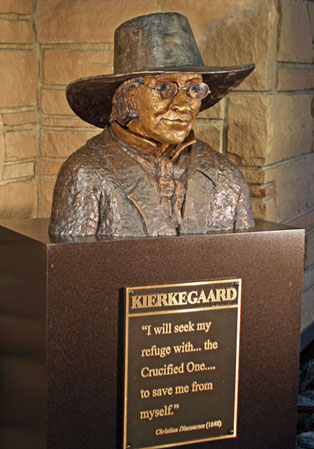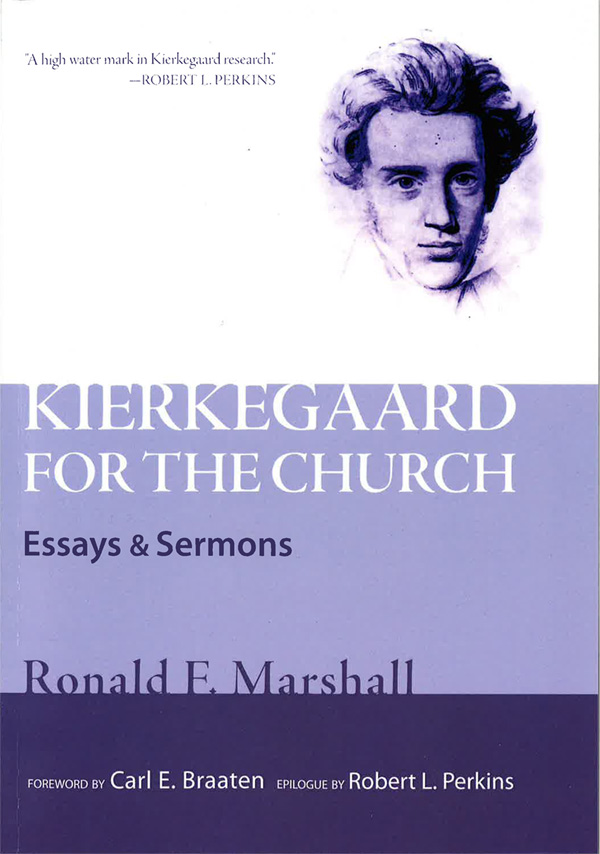
The Kierkegaard Bicentennial
-----------------------------------------------------------------------------------------------------------------
November 17, 2013
By Pastor Marshall
|
We have been commemorating Søren Kierkegaard (1813-1855) and his
profound witness to Jesus Christ every November since 1980. In
2013 we celebrated on November 17th Kierkegaard's bicentennial
of his birth on May 5th. At our commemoration we dedicated the
Rita Marie Kepner bronze statue of Kierkegaard and read the new
Dana Gioia commemorative poem in homage to Kierkegaard. We also
had a book signing of my new book,
Kierkegaard for the
Church: Essays and Sermons. (Eugene, Oregon: Wipf & Stock). At the Sunday
morning liturgy, the prelude was the Aria from Bach's Cantata
183, "I Fear Not Death's Terror." The tenor was Christopher
Freeze, and the cellist was Ruth Marshall, with organist, Andrew
King. The Hymn of the Day was "Commit Thy Way, Confiding," by
Paul Gerhardt (1606-1676), with a new tune by Carl Schalk (b.
1929). This was Kierkegaard's favorite hymn (Journals,
ed. Hong & Hong, 6:6673). Distribution music was "A
Kierkegaardian Fugue," a new composition by Josh Deutsch, based
on a passage from Kierkegaard's 1848 book,
Christian Discourses.
The three
texts follow, along with the live recording from the
commemoration. Thanks to Dale Korsmo for helping prepare this
recording for posting. |
||
|
CLICK BELOW TO LISTEN.
|
|
Ich fürchte
nicht des Todes Schrecken Ich scheue
ganz kein Ungemach.
Denn Jesus'
schutzarm wird mich decken,
Ich folge gern und
willig nach;
Wollt ihr nicht
meines Leben schonen
Und glaubt, Gott
einen Dienst zu tun,
Er soll euch selben
noch belohnen,
Wohlen, es mag
dabei beruhn. |
I do not
fear the horror of death, no hardship
at all scares me.
For Jesus'
protective arm will cover me,
I gladly and
willingly follow after Him;
if you do not wish
to spare my life
and believe you are
doing God a service,
He Himself will yet
reward you,
indeed, this can be
relied upon! |
|
Commit Thy Way, Confiding
|

|
Helping Out My Daughter:
Reviewing Ronald F. Marshall’s
Kierkegaard for the
Church
(
By Rollie Storbakken
I STAND GUILTY AS
CHARGED
on p. 9, footnote 34, in Pastor
Marshall’s new book on Kierkegaard, of “accommodating the
Christian revelation to human desires.” I didn’t even need my
dictionary to help me figure out that part of his book, but I
did find my dictionary necessary to understand most of the rest
of it.
Let me explain . . .
I
can only remember reading three maybe four books in my
fifty-nine years of life – the Bible, and the biographies of
Crazy Horse and Hank Williams. So this review comes from a
retired Union ironworker – who was only required to use and
understand four letter words for thirty-five years, and before
that was raised in a horse barn.
So the reading – or studying – of this book was a lot of work
for me. I looked up every word I didn’t understand and penciled
in the meanings, off to the side of the page, knowing that this
would help me re-read the book later with greater ease and
understanding. I found something on every page I felt I had to
underline and stress for future study. The book is so full, in
my uneducated opinion – not that I know much about books, mind
you.
Just to let you know, here are a
few examples of my smiles and tears as I read through this book.
I had to read footnote 49 on p. 14 over a couple times to get
the important difference between the theologians of glory and of
the cross. (I found that my coffee always got cold while
studying this book.) Footnote 18 on p. 80 is too heavy and still
beyond me: “Only one’s loving care for others is to be loved in
self-love. The self itself is not to be loved in self-love.” I
still ponder this line on p. 106: “challenging ecclesiastical
authority.” But the quotation in the middle of p. 125 still
baffles me: “If this untruth is not included, then the
extraordinary does not remain the extraordinary; it is taken in
vain.” Even so there was also hope and relief, as in footnote 47
on p. 189: “Ah, delicious coolness,” as well as Kierkegaard’s
love for the common man on p. 244. And I like the summaries by
Pattison and Perkins in footnotes 59 and 60 on p. 195. And then
there is that great footnote 15 for kids on p. 219, and the
wonderful prayer at the bottom of p. 228 – especially for my 9
year old daughter, Silvie.
In spite of these difficulties, I made myself read all of the
footnotes on every page of this book. I didn’t skip over any of
them like I thought of doing. After Matins, one Wednesday
morning in December, I told Pastor Marshall I was still working
on his book and that pp. 122 and 192 were two of my favorites.
He later told me he looked them up and was happy to hear I liked
them because he thought there were some pretty good ideas on
those two pages. But that wasn’t why I liked them. I later told
him I had jokingly picked them because they were two of the very
few pages in his book without any footnotes on them!
But by p. 63, I had settled in and started circling every little
footnote number on each page to make them stand out so that
going back and forth between the footnotes and the main text was
easier for me to do. I highly recommend this to help you get all
that is packed into this book.
For the record, I started reading it – that is, going on my
educational adventure with it – in October 2013, shortly after
the books went on sale in church. I finished my first reading of
it on January 18, 2014.
Why did I choose this book to be
one of the only books I will ever read in my lifetime? Remember
I’ve only read three or four books in my fifty-nine years. Well,
the answer is that a friend of mine – my pastor – is the one who
wrote it! And how many authors do any of us know personally?
So, as an all-or-nothing type of guy, I decided to do my best to
get to know this book. And that means that I’ll need to keep
going over it until I die, because it’s about Christianity, and
that’s the way our faith is. So there’s enough
education-explanation in this work – when I go to look up the
related Bible verses and footnote references – to keep me
informed and busy. And then to understand and believe. In
comprehending this book I feel I will stand – when kneeling – a
better chance of making the team, if you know what I mean. It
might take ‘til I die to let go of this world and grasp what
this book is about (see p. 307). That will be the moment I hope
to leave you all behind.
My copy of this book, with all of its markings, is now a family
treasure to be left to Silvie, to be read when she gets older.
I’ve made notes in it like, “Silvie, look here” – with arrows
Èand other
markings to help her focus on, hear and learn about, what I
believe are the foundational, “light bulb” parts of Christianity
as explained in this book. And it’s full of them – which are the
guts of Luther, Kierkegaard and Pastor Marshall! So my notes
will help Silvie take in, and then digest, this book. I hope the
notes to her and my markings will be the sugar that helps the
medicine go down. I write “here’ in the book with arrows
pointing where she should pay attention. I write “learn this,”
and “here too is the answer.” I write “Look” with eyes drawn in
the double “o”s. I write “Here lies the heart of the book,” with
arrows showing the way. I want to help her – after I’m dead and
gone – to catch what this book has to say about real
Christianity and how it goes against the herd (you’ll have to
read the whole book, especially pp. 125 and 233-35, to get that
one)! I would also love to have embroidered the three prayers on
p. 215 so we could frame them and hang them in our house so we
don’t forget them!
One sentence that really encouraged me was on p. 324, where
Kierkegaard says: “I myself manage to be only a very simple
Christian.” Pastor Marshall adds that this means Christians are
“always on the road to becoming” Christians. In a nut shell,
then, Christianity is about this “continuous striving” (see also
p. 212). For me this is the ammunition we’ll all need to stay
warm in Christ Jesus through the many struggles of this life. So
read your Bibles – for God’s Word is your defense when things
pile up against you. And may we all receive the Holy Spirit so
that we’ll be able to understand His Word when we finally pick
it up and study it – which is what this book wants all of us to
do (see pp. 150-53).
Makes Kierkegaard’s Ideas
about the
Church and Christianity
Understandable
By Ben Johnson
(posted online at Amazon.com, May 20, 2014)
KIERKEGAARD IS A GENIUS
that everybody would like to read and to understand, but
sometimes we find ourselves lost in the density of his thought
and especially in Kierkegaard’s rather famous flitting from one
idea to another.
This book, Kierkegaard
for the Church, brings into clear focus much appreciated
structure and commentary to Kierkegaard’s writings – with each
chapter exploring a different idea in detail and length, yet
without belaboring any of the individual points.
What’s more amazing is that this is done without “dumbing-down”
Kierkegaard’s expressions – in fact, precisely the opposite.
This book is dense with ideas and thought, and can rightly be
described as a distillation. It reads very slowly like native
Kierkegaard, but you never wind up getting lost or wondering
what happened.
For me this book will go in my library right next to Douglas R.
Hofstadler’s Pulitzer Prize winning
Gödel, Escher, Bach: An
Eternal Golden Braid (1980) – for re-reading about every six
years.
|

